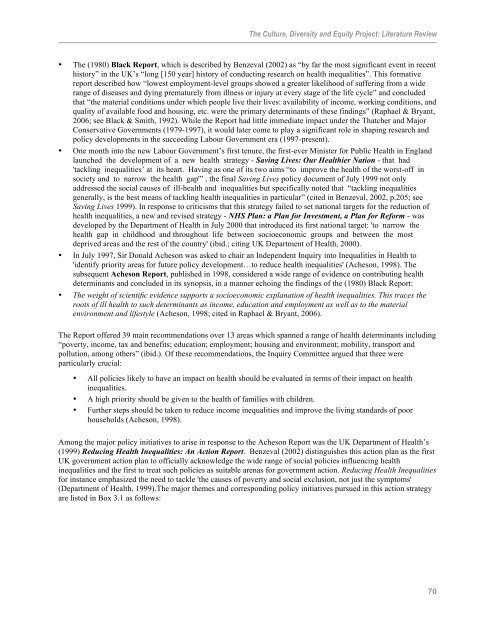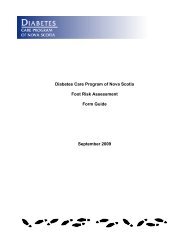CDE Appendix 1 Literature Review - Central East Local Health ...
CDE Appendix 1 Literature Review - Central East Local Health ...
CDE Appendix 1 Literature Review - Central East Local Health ...
Create successful ePaper yourself
Turn your PDF publications into a flip-book with our unique Google optimized e-Paper software.
The Culture, Diversity and Equity Project: <strong>Literature</strong> <strong>Review</strong><br />
• The (1980) Black Report, which is described by Benzeval (2002) as “by far the most significant event in recent<br />
history” in the UK’s “long [150 year] history of conducting research on health inequalities”. This formative<br />
report described how “lowest employment-level groups showed a greater likelihood of suffering from a wide<br />
range of diseases and dying prematurely from illness or injury at every stage of the life cycle” and concluded<br />
that “the material conditions under which people live their lives: availability of income, working conditions, and<br />
quality of available food and housing, etc. were the primary determinants of these findings” (Raphael & Bryant,<br />
2006; see Black & Smith, 1992). While the Report had little immediate impact under the Thatcher and Major<br />
Conservative Governments (1979-1997), it would later come to play a significant role in shaping research and<br />
policy developments in the succeeding Labour Government era (1997-present).<br />
• One month into the new Labour Government’s first tenure, the first-ever Minister for Public <strong>Health</strong> in England<br />
launched the development of a new health strategy - Saving Lives: Our <strong>Health</strong>ier Nation - that had<br />
'tackling inequalities’ at its heart. Having as one of its two aims “to improve the health of the worst-off in<br />
society and to narrow the health gap'” , the final Saving Lives policy document of July 1999 not only<br />
addressed the social causes of ill-health and inequalities but specifically noted that “tackling inequalities<br />
generally, is the best means of tackling health inequalities in particular” (cited in Benzeval, 2002, p.205; see<br />
Saving Lives 1999). In response to criticisms that this strategy failed to set national targets for the reduction of<br />
health inequalities, a new and revised strategy - NHS Plan: a Plan for Investment, a Plan for Reform - was<br />
developed by the Department of <strong>Health</strong> in July 2000 that introduced its first national target: 'to narrow the<br />
health gap in childhood and throughout life between socioeconomic groups and between the most<br />
deprived areas and the rest of the country' (ibid.; citing UK Department of <strong>Health</strong>, 2000).<br />
• In July 1997, Sir Donald Acheson was asked to chair an Independent Inquiry into Inequalities in <strong>Health</strong> to<br />
'identify priority areas for future policy development…to reduce health inequalities' (Acheson, 1998). The<br />
subsequent Acheson Report, published in 1998, considered a wide range of evidence on contributing health<br />
determinants and concluded in its synopsis, in a manner echoing the findings of the (1980) Black Report:<br />
• The weight of scientific evidence supports a socioeconomic explanation of health inequalities. This traces the<br />
roots of ill health to such determinants as income, education and employment as well as to the material<br />
environment and lifestyle (Acheson, 1998; cited in Raphael & Bryant, 2006).<br />
The Report offered 39 main recommendations over 13 areas which spanned a range of health determinants including<br />
“poverty, income, tax and benefits; education; employment; housing and environment; mobility, transport and<br />
pollution, among others” (ibid.). Of these recommendations, the Inquiry Committee argued that three were<br />
particularly crucial:<br />
• All policies likely to have an impact on health should be evaluated in terms of their impact on health<br />
inequalities.<br />
• A high priority should be given to the health of families with children.<br />
• Further steps should be taken to reduce income inequalities and improve the living standards of poor<br />
households (Acheson, 1998).<br />
Among the major policy initiatives to arise in response to the Acheson Report was the UK Department of <strong>Health</strong>’s<br />
(1999) Reducing <strong>Health</strong> Inequalities: An Action Report. Benzeval (2002) distinguishes this action plan as the first<br />
UK government action plan to officially acknowledge the wide range of social policies influencing health<br />
inequalities and the first to treat such policies as suitable arenas for government action. Reducing <strong>Health</strong> Inequalities<br />
for instance emphasized the need to tackle 'the causes of poverty and social exclusion, not just the symptoms'<br />
(Department of <strong>Health</strong>, 1999).The major themes and corresponding policy initiatives pursued in this action strategy<br />
are listed in Box 3.1 as follows:<br />
70

















